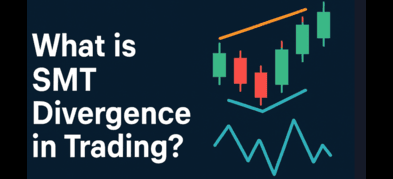How to use dmi indicator to spot trade signals
In technical analysis, the DMI indicator (Directional Movement Index) is an important tool for assessing trend strength. It was introduced by J. Welles Wilder in 1978.
It consists of three lines: +DI, −DI, and ADX, which are used to determine whether the market has a clear directional trend. This helps traders avoid range-bound conditions and focus on true trending opportunities.
How does the DMI indicator work?
The core of the DMI indicator lies in observing the crossover between positive directional movement (+DI) and negative directional movement (−DI), and further using the strength of the ADX line to determine whether the trend has actionable value.
When +DI is greater than −DI, it indicates bullish dominance; conversely, bearish control is implied when −DI exceeds +DI. If the ADX value rises, it signifies a strengthening trend, making it suitable for trend-following strategies.
Components of the DMI indicator
The DMI consists of the following three components:
- +DI: Measures the strength of upward price movement.
- −DI: Measures the strength of downward price movement.
- ADX: Indicates the strength of a trend, regardless of direction. Through the interaction of these three components, traders can intuitively determine whether the market offers a valid entry signal. It is a widely relied upon trend analysis tool among forex and commodity traders.

Relationship Between the DMI Indicator and ADX
The DMI indicator is closely related to ADX, as ADX itself is derived from the difference between +DI and −DI. A rising ADX value indicates a developing trend. When +DI and −DI cross and ADX is above 25, it is typically seen as the beginning of a strong trend.
This is particularly important for traders using leveraged instruments such as CFDs, as strong trends present both greater opportunities and increased risks.
Application of the DMI Indicator in the Forex Market
In the forex market, the DMI indicator is particularly useful because currency pairs often exhibit prolonged trending behavior. By monitoring the crossover positions of +DI and −DI along with the strength of ADX, traders can determine whether to follow the trend.
For example, in the EUR/USD pair, when +DI continues to rise and ADX is above 30, it signals a strong bullish trend, making it suitable for buying on pullbacks.
How to Set DMI Indicator Parameters?
By default, the DMI indicator is typically set to a 14-period configuration, which is supported by most trading platforms including the UM trading system. However, frequent traders may adjust it to a 7-period setting to enhance responsiveness.
It is important to note that a shorter period may introduce more noise into the signal and should be used alongside other indicators such as MACD or Bollinger Bands for confirmation.
Comparison Between DMI and Other Technical Indicators
Compared to moving averages, the DMI indicator has the advantage of clearly indicating trend strength, while moving averages only reflect direction.
Compared to RSI, which focuses on overbought and oversold conditions, the DMI indicator provides a more reliable assessment of trend development, making it more suitable for medium-term traders.
What Are the Trading Strategies for the DMI Indicator?
Here are two common strategies:
- Trend Breakout Strategy: Go long when +DI crosses above −DI and ADX is above 25; go short when −DI crosses above +DI under the same ADX condition.
- Trend-Following Entry Strategy: Build positions on pullbacks during periods of rising ADX to improve the risk-reward ratio. When using Ultima Markets, these strategies can be automated by configuring technical conditions, thereby enhancing trading efficiency.

Advantages of Using the DMI Indicator on the UM Platform
Using the DMI indicator on the UM platform offers the following advantages:
- Multi-platform support (MT4, MT5, and Web)
- Customizable technical indicator parameters
- Real-time trend updates and mobile alert features Users only need to open a trading account to access the full range of technical analysis features immediately.

Pros and Cons of the DMI Indicator
Pros:
- Effectively filters out range-bound periods
- Clear structure and easy to interpret
- Applicable across various timeframes and markets
Cons:
- Slightly lagging in signal response
- May generate frequent false signals in sideways markets It is therefore recommended to use it in conjunction with trendlines and volume indicators for cross-validation.
Real Case Analysis of the DMI Indicator
Taking the early 2023 gold trend as an example, both +DI and ADX rose simultaneously, indicating strong bullish momentum. Within the following three weeks, gold prices surged over 7%, demonstrating the practical value of the DMI indicator in real trading scenarios.

FAQ
Q1: What is the DMI indicator?
A: It is a technical indicator used to determine the strength and direction of a market trend, consisting of three lines: +DI, −DI, and ADX.
Q2: What is the difference between the DMI indicator and ADX?
A: DMI is the complete system, while ADX is the specific line within it that measures trend strength. They are used in a complementary manner.
Q3: What types of assets are suitable for the DMI indicator?
A: It is best suited for trend-driven assets such as forex, gold, crude oil, and index products.
A: It is best suited for trend-driven assets such as forex, gold, crude oil, and index products.
A: It is recommended to use it alongside RSI or Bollinger Bands to filter out false signals and improve accuracy.
Q5: Where can I practice using the DMI indicator? A: You can apply for a demo account on the UM platform to practice trading strategies risk-free.
Conclusion: Master the DMI Indicator to Master the Trend
Whether you’re a short-term speculator or a medium-to-long-term investor, the DMI indicator can help you effectively assess trend direction and strength.
On the UM platform, you can enhance your trading decision-making skills through various tools and simulations, reducing the chances of incorrect decisions and making every entry and exit more justified.
Disclaimer: This content is provided for informational purposes only and does not constitute, and should not be construed as, financial, investment, or other professional advice. No statement or opinion contained here in should be considered a recommendation by Ultima Markets or the author regarding any specific investment product, strategy, or transaction. Readers are advised not to rely solely on this material when making investment decisions and should seek independent advice where appropriate.
























